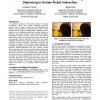59 search results - page 9 / 12 » A Computer Simulation Laboratory for Social Theories |
SIVP
2010
13 years 5 months ago
2010
Resource aware operation of sensor networks requires adaptive re-organization to dynamically adapt to the operational environment. A complex dynamical system of interacting compone...
TWC
2010
13 years 2 months ago
2010
Optimized opportunistic multicast scheduling (OMS) is studied for cellular networks, where the problem of efficiently transmitting a common set of fountain-encoded data from a sin...
ASYNC
2000
IEEE
13 years 11 months ago
2000
IEEE
Fault Abstraction and Collapsing Framework for Asynchronous Circuits Philip P. Shirvani, Subhasish Mitra Center for Reliable Computing Stanford University Stanford, CA Jo C. Eberge...
WIKIS
2009
ACM
14 years 2 days ago
2009
ACM
Learning “the wiki way”, learning through wikis is a form of selfregulated learning that is independent of formal learning settings and takes place in a community of knowledge...
HRI
2011
ACM
12 years 11 months ago
2011
ACM
To seamlessly integrate into the human physical and social environment, robots must display appropriate proxemic behavior—that is, follow societal norms in establishing their ph...

